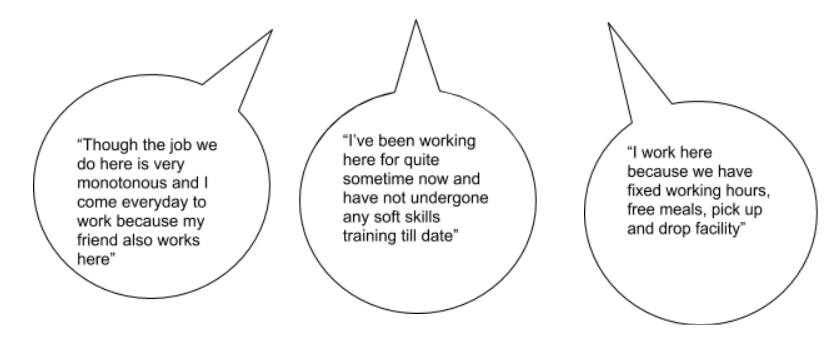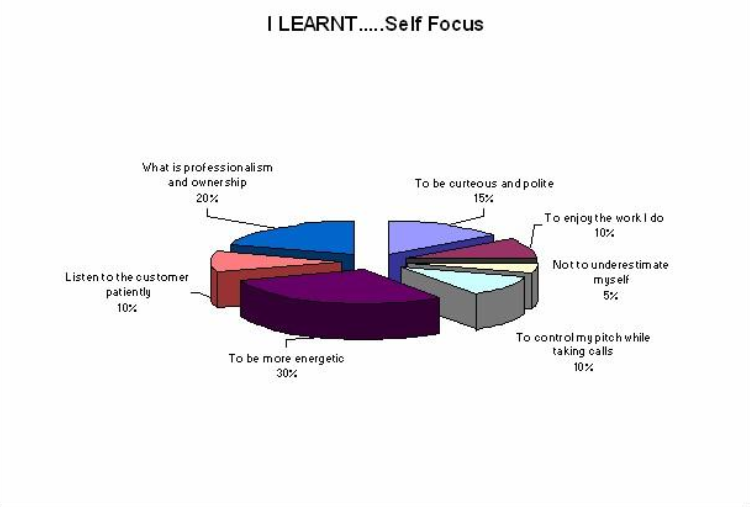Introduction:
“All this talk about Appreciative Inquiry is good but can it really impact business results?”
Training seems to be the need of HR and Training people more than the need of the business people. ‘All that wishy washy stuff is good for the class room but does not help. Only feels good, that’s all’
This may sound familiar almost like a cliched statement. People in business and operations roles are ‘cynical’ or skeptical at best about the training initiatives.
Both as an inside consultant to one of the leading BPO organizations in India and as an external consultant to one of the leading telecom companies and my conversations with many Business Heads, Operations Heads and CEO’s I was witness to this kind of conversation many times in the past.
Therefore, we decided to challenge ourselves by claiming that
‘training initiatives directly impact business results’
Since ‘Customer satisfaction’ was a clearly measurable and quantifiable goal in many organizations, we decided to work on that.
The present study talks about one such project we did for one of the leading organizations in India. (all names changed due to confidentiality agreement with the client)
Client: A leading telecom company –Telmore
Participants: The operations team in one of the geographies consisting of Team leaders, trainers, customer service representatives
Synopsis: Telecom industry in India is a very fast growing and highly competitive industry where the cost of the technology is coming down by the day. Meaning thereby the survival and the growth depends on sales growth. Customer happiness in such a scenario is of prime importance because customer has many choices. The only differentiator in such a scenario remains “Excellent customer service” Secondly in this dynamic environment employees do have many options thereby rate of attrition is high.
So the task is two fold:
- To enhance the skills of the participants
- To enhance their stickiness with the job and therefore the organization
In june’06, Rohit Gandhi, the training Head of ‘customer care’ division of Telmore engaged Idam Learning to design an intervention with an objective to enhance the customer experience at their customer care centre. “Coretech’ is the customer care center wherein people are engaged in providing telephonic services to premium customers to help them use their services better. This consists of trouble shooting, handling any kind of billing queries, technical problems, network related problems and any other value added services. Idam Learning’s “Customer intimacy intervention” is an integrated program that develops skills, imparts personal executive coaching, helps in developmental experiences and gives action learning.
The project started with a comprehensive diagnostic exercise involving meetings with all the key stakeholders at all levels across functions.
Idam Learning facilitators spent hours on the operations floor listening into live and recorded calls. This was followed by a pilot program, which was conducted over a period of 6 days in 2 batches. The training focused on two areas:
Understanding self: First module was devoted to helping the participants explore their fears and blocks. This was followed by a deeply engaging activity which resulted in an understanding of their hopes and hidden potential and a drive to set stretch goals for themselves.
The skill building session comprised of simulation and role-plays based on real life scenarios. Training concluded with a personal action script for every participant.
Coaching Sessions: This training was followed up by one-on-one coaching sessions with each participant. Idam learning facilitators also gave feedbacks to the managers.
Visible change began on the first day after the training program when the floor was packed with energetic and enthusiastic people. Their customer satisfaction scores showed a significant movement and the journey continues…
Hypothesis
We worked with the hypothesis that customer satisfaction is a function of the attitude of the ‘company employee’ who is in touch with the customer. This assumes that the organization has reasonably competitive product in the market. The only differentiator in this scenario is how the customer is treated by the ‘associate’.
Further, the attitude of the employee is a function of two parameters:
- How skilled the person is… communication, negotiation, customer sensitivity, patience, listening etc.
- How happy the person is: If people are intrinsically happy, then they perform well. No amount of soft skills training works if the employees are not happy with their work environment, the way they are treated in the organization, the quality of relation they have with their supervisors.
Therefore, an intervention which is a combination of the above two aspects is required in order to get the person feel connected with his/her job and also perform to his/her full potential .
Methodology
We worked with one ‘Real Team’ which was engaged with serving premium clients. These premium clients accounted for approximately 40% revenue of the organization in the select geography. The participants in the intervention were:
Customer facing people, Team Leaders and Operations Managers.
Following interventions were used:
- Group workshops
- One-on-one Coaching
- Small group coaching
- Mystery shopping
- Floor support
- Process observation
- Process mapping
- Measurements and benchmarking of quality and third party scores
Underlying Philosophy & Conceptual Frameworks
- Appreciative Inquiry:
Appreciative Inquiry (AI) is a philosophy, a world view, a powerful perspective and a process that engages people at all levels of the organization. The core of the Appreciative inquiry is that it shifts the focus of energy from deficit-based problem solving to strengths-based solution focused theory. For organizations to be the best they can be, they must be comprised of individuals and groups that are also operating at their best. AI is a powerful approach to build leadership that empowers and frees the potential of people in a way that it liberates the best of what’s possible in organizations. The Appreciative Inquiry approach is equally effective in large businesses and small intimate systems. We used Appreciative inquiry to give feedback and coach and support people on the floor. We also used AI to coach team leaders and managers.
- David Kolbe’s experiential learning Cycle:
We used David Kolbe’s Experiential learning methodology for conducting all training interventions. The learning cycle
- Experience
- Reflect & Share
- Hypothesis, theory and Coneptualization
- Active observation
- David Mclelland’s Theory of Achievement Motivation:
The two drivers of success ‘Hope for success and Fear of failure and why is it important for people to set moderately high and stretch goals for themselves.
- Skill Building:
Skill building was done in the following areas:
- Assertiveness
- Customer sensitivity
- Negotiation
- Listening
- Questioning
- Coaching and helping
Sensing and Diagnosis Exercise
Listening to the voice of the customer:
Idam Learning facilitators spent hours on the floor listening in to customer calls, talking to employees one-on-one, conducting focus groups, observing processes and behaviours. The policies of the company were very customer oriented, the executives had all the powers to give freebies, waivers as and when required. Despite very liberal policies of the company, employees were not able to delight the customer. They perhaps lacked certain critical skills and the drive and the energy to connect with the customers. They particularly had issues in the areas of objection handling and building rapport with the customer.
Listening to the voice of the people:
People on the floor, though loved the organization were demotivated and de-energized due to many reasons. Some of the possible reasons as reported were:
- repetitiveness of the job
- very demanding nature of customers
- lack of role models
- lack of skills to handle objections
- lack of growth opportunities
- lack of ownership
In addition, they had an attitude of blaming external factors (organization, bosses, systems etc) for every failure or struggle they were going through. They were not taking any responsibility for themselves and their performance. They complained of many things including the fact that they resented their being treated like numbers. There seemed to be a lack of human touch and empathy…
Fig. 2. Voice of the employees on the floor
How did the learning journey unfold??
The program started with a journey into self, the purpose of the training was to transform the basis of communication in the minds of the participants. The objective was to sharpen the communication skills of the participants with special emphasis on being empathetic, listening, understanding mind of the customer and aligning to his/her needs.
Day 1: understanding Self: The program unfolded with journey into self through use of profiling instruments and activities. People explored their fears and beliefs and got in touch with their strengths. The day ended with people in a reflective mode and a heightened self-belief in themselves.
Day 2: How to communicate: On this day people did a lot of action learning. A lot of role-plays from their daily work life were played which gave them an insight about handling the problems in a better way. Much emphasis was laid on improving their communication skills also.
Day 3: Being in the shoes of the customer: This day was a combination of both self-assertion and understanding where lays the gap between the customer’s expectations and the current state. Then we moved on to understanding the psychology of the customer and strategies to align with the customer. The day concluded with making a personal script by each participant.
Coaching:
The last step was one-on-one coaching. Immediately after the program once again Idam Learning facilitators were on the floor listening to the calls wherein the agents were practicing their new skills. One-on-one coaching sessions were organized wherein feedback was given to each and every participant.
The change was visible on the first day after the intervention as the floor was full of energy with enthused people, who had connected with their work with a whole new meaning, They were all set to commit their 100% towards the jobs assigned. The same was on records after a month when the scores were measured again both internally and externally.
How did this impact the results?
Fig. 4. This is what agents said after the intervention
Fig. 5. Participant’s insights during Coaching
Fig. 6. & 7 one thing I learnt…self focus and customer focus
Conclusion
What worked for us in this intervention was the involvement of the entire operations team with a positive intent and commitment to make a difference. Sustained intervention where message is reinforced through coaching and sustained engagement of people across levels works better than stand-alone programs.
The power of Appreciative inquiry was revealed when the entire team started focusing on and learning from the best calls of everyone instead of learning from the ‘worst calls’ in the meetings. This way, no one was embarrassed and people had to live up to the hi-dream they set themselves for.
The collective conscience of the entire team raised the energy level of the entire function and the customer satisfaction level moved up in double digits in a period of 90 days. Customer satisfaction both quantitatively and qualitatively increased by double digits. Employee engagement also got enhanced. People felt more valued and cared for as people vis-à-vis being treated like numbers in the past.
The most startling finding was that it is the coaching of the ‘supervisors’ that impacted the customer experience more than training the ‘customer facing people’. which impacted the overall matrices.






0 Comments Leave a comment